Offshore wind farm developments - public perceptions: survey
Findings from a survey exploring public perceptions of offshore wind farm (OWF) developments in Scotland. It describes whether and how respondents in Scotland have been impacted by OWFs, their attitudes to OWFs, and how OWFS affect their tourism and recreation choices.
This document is part of a collection
5 Impacts of offshore wind farms
To explore the impacts of offshore wind farms on communities closest to developments, the survey contained questions asked of those with lived experience of offshore wind farms, as defined earlier as those 'who have the same outward postcode as an area which is used during the construction of an offshore wind farm.' Using this definition, a total of 244 respondents within the coastal sample had 'lived experience' of an offshore wind farm.
5.1 Approval of offshore wind farms
Among this lived experience sample, a clear majority (85%) indicated that they approved of offshore wind farms before one was developed nearby, and still approve of them now, as illustrated in Figure 5.1. Just 6% have changed their minds about offshore wind farms since one was developed; 4% have become more positive in that period while 2% have moved in the opposite direction.
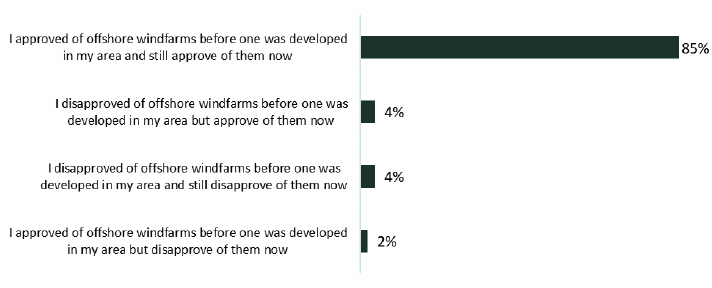
Base: Those near to an offshore wind farm, excluding those with 'don't know' responses (186)
Further analysis was carried out to explore any common traits held by those who changed their opinion about offshore wind farms, including consideration of gender, age, location, social grade, UR6 code and awareness of each offshore wind farm; no significant relationships were found in the data.
The very small numbers of lived experience respondents who have changed their mind about offshore wind farms were asked to give reasons for this change. Those who now approve of offshore wind farms often commented on the direct benefits of developments, their increased knowledge of offshore wind farms and the benefits they bring to the community as the reason for changing their opinion.
"Job creation, renewable energy, no pollutants and don't use water. Before I was ignorant of the benefits."
(Aberdeen)
"I think greater use should be made of wind and tidal power. I did not know what the benefits were of using these and we have to get into a situation where we use less of the world's resources."
(Neart na Gaoithe)
Lived experience respondents who now disapprove cited the impact on wildlife and seascapes as reasons to oppose offshore wind farms.
"They ruin the view when built close to shore. I believe they are the cause of marine wildlife, whales especially, losing their bearings because of underwater vibrations set up by the turbines. The farms are over illuminated and ruin the dark sky."
(Beatrice)
It is important to note that those who disapprove of offshore wind farms after having experience of a development nearby, did not cite any direct impact to themselves or their lifestyle as a reason for disapproval.
All respondents, national and coastal, were asked to consider the factors which might change their mind about offshore wind farms in the future. In response to this open-text question the majority of those who already approved of offshore wind farms do not expect to change their mind in the future, suggesting that they see offshore wind farms as a long-term positive feature.
"I doubt if my mind would change as they are a better alternative than other options."
(Beatrice)
"Nothing will change my mind. I think it is an amazing way to provide energy."
(Robin Rigg)
5.2 Impacts of offshore wind farms
Two-thirds of lived experience respondents (66%) agreed with the statement that offshore wind farms provide a boost for the local economy, while two in five (41%) agree that they are a positive feature of the coastal landscape and around a third (34%) agreed that they create new recreational opportunities (Figure 5.2). Despite the overall positivity around offshore wind farms in this sample, opinion is equally divided over their impact on the traditional image of the coast, with 34% agreeing that they detract from that image and the same proportion disagreeing.
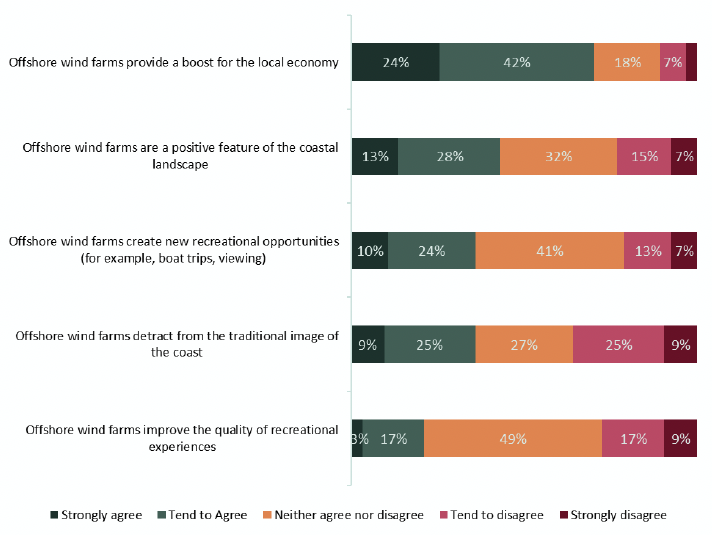
Base: Those near to an offshore wind farm (244)
Sub-group analysis of this question revealed that 34% of those aged between 45 to 54 strongly agree with the statement that offshore wind farms provide a boost to the local economy, compared to only 17% of those aged 65 and over. This may reflect the experience of those of working age who can see the economic benefits more closely. No other significant relationships were found in the data.
5.3 Community impacts
When those with lived experience of offshore wind farms were asked a series of questions about specific impacts, in most cases the responses suggested that the impact has largely been neutral. In particular 75% said that the local offshore wind farm has no impact on their livelihood, while 70% say the same for the impact on the value of their home (Figure 5.3). There is evidence of a perceived positive impact of offshore wind farms; in particular 43% said that offshore wind farms have a positive impact on their feelings for the future, while 33% perceived a positive impact on local infrastructure. Opinions on the impact of offshore windfarms on the local landscape/seascape character were split fairly evenly, with 27% saying that offshore wind farms had a positive impact and 25% saying that the impact was negative. Positive responses outweigh negative responses for all issues covered.
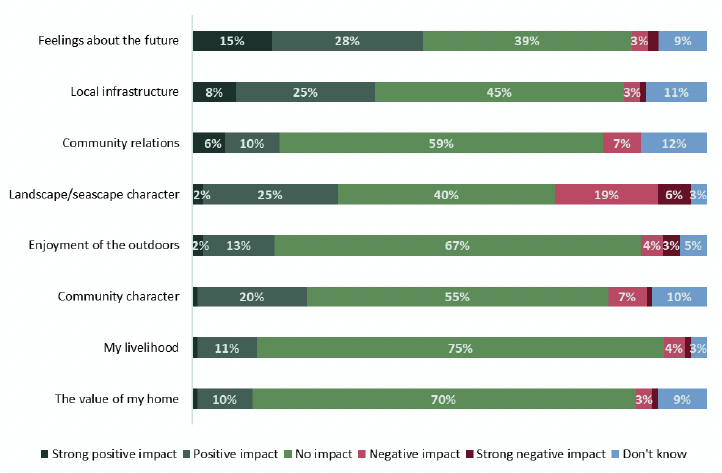
Base: Those near to an offshore wind farm (244)
Respondents said that the impacts they experienced were broadly in line with what they expected. It is worth noting, however, that the benefits for the local community and local job opportunities have been better than expected for around a fifth of residents (19% and 20% respectively) (Figure 5.4).
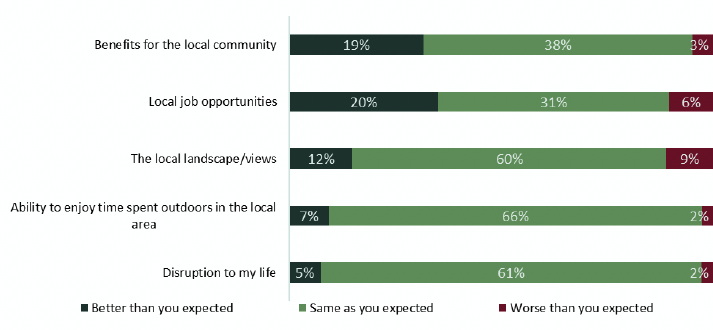
Base: Those near to an offshore wind farm (244)
Sub-group analysis was not possible as the sub-groups were too small for statistical tests to be valid (see section 1.8 Analysis and Reporting for more details).
5.4 Quality of life impact
In terms of overall quality of life, nearly two-thirds (63%) of lived experience respondents felt that offshore wind farms had had no impact as shown in Figure 5.5. For those who reported an impact, those reporting a positive impact (25%) outweighed those reporting a negative impact (4%) by six times.

Base: Those near to an offshore wind farm (244)
Similarly, when looking at a range of specific impacts, listed in Figure 5.6, in all cases, the vast majority of lived experience respondents reported either no impact or that they did not know. The impacts which had most positive ratings were community benefit schemes (27% saw as positive) and the broader port area (23%).
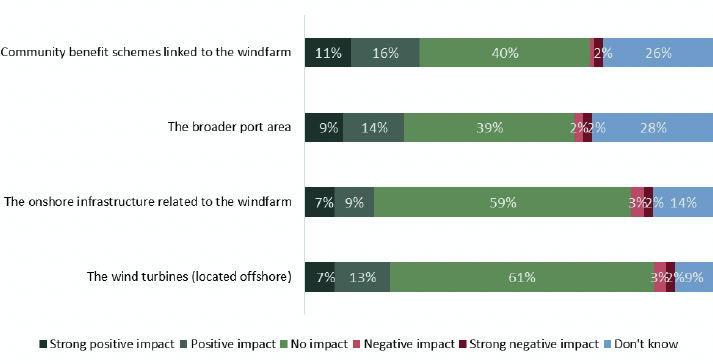
Base: Those near to an offshore wind farm (244)
Community benefits are a renewable industry led voluntary initiative to support communities – often in the form of funds. As they are designed to have a positive impact on communities near windfarms, it is notable that 40% of respondents felt that these schemes had had no impact.
Contact
Email: ScotMER@gov.scot
There is a problem
Thanks for your feedback